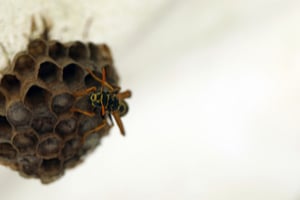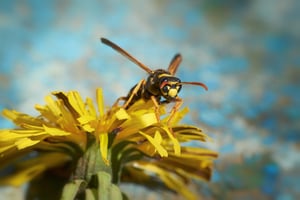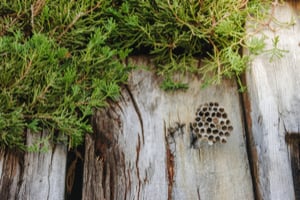If it seems like you’re seeing wasps way more often now that it’s summer, we have some good news and some bad news. We’ll get the bad news out of the way first. If you see wasps on your property a lot right now, it’s probably because they built a nest nearby. The good news: you can do something about it. Here’s everything you need to know about the wasps you keep running into this summer. By learning what makes the sinister stingers of summer tick, you can much more effectively keep them from bothering you.
Why are wasps more active in summer?
 Every year in spring, queen wasps re-emerge their overwintering sites to seek new places to nest. The ideal nesting location is inaccessible to predators, protected from exposure, and close to food and building materials. When the wasp queen finds a suitable nest, they begin laying eggs to start a new colony. When these eggs hatch, the resulting workers build out the nest while the queen keeps reproducing… and reproducing.
By summer, wasp colonies have reached peak population. Hundreds to thousands of workers inhabit a nest and spend all day hunting down food to feed their young. Naturally, the higher the wasp population, the more wasps you’re likely to encounter. In other words, it’s not that wasps are necessarily more active during summer; there are just more of them. Fortunately, during summer wasps don’t generally wander too far away from their nests. Unfortunately...
Every year in spring, queen wasps re-emerge their overwintering sites to seek new places to nest. The ideal nesting location is inaccessible to predators, protected from exposure, and close to food and building materials. When the wasp queen finds a suitable nest, they begin laying eggs to start a new colony. When these eggs hatch, the resulting workers build out the nest while the queen keeps reproducing… and reproducing.
By summer, wasp colonies have reached peak population. Hundreds to thousands of workers inhabit a nest and spend all day hunting down food to feed their young. Naturally, the higher the wasp population, the more wasps you’re likely to encounter. In other words, it’s not that wasps are necessarily more active during summer; there are just more of them. Fortunately, during summer wasps don’t generally wander too far away from their nests. Unfortunately...
Where are wasps coming from?
 ...That means if you see a lot of wasps around your home, it’s probably because there’s a nest nearby. Wasps often build nests near or on homes, because homes satisfy wasp nest requirements. First, wasps need a place where their nest can remain inaccessible to predators. Frequently, wasps build their nests on eaves, overhanging parts of roofs, high corners, or even in chimneys. Wasps can hang their nests from just about any base, however, so any high, hard-to-reach area works for them.
Along with a secluded place, wasps need building material and a food source near their nests. Workers use wood fiber to build and expand their nests. They break down weathered wood fiber, mix it with saliva to form a pulp, and shape the nest with that pulp. Rotting or damaged bark, old wooden fences, or damaged siding make perfect building material. Wasps are general predators, so the food source they’re looking for are other, smaller insects. If your home is near an insect hotspot like a river or woods, wasps are more likely to build nearby.
...That means if you see a lot of wasps around your home, it’s probably because there’s a nest nearby. Wasps often build nests near or on homes, because homes satisfy wasp nest requirements. First, wasps need a place where their nest can remain inaccessible to predators. Frequently, wasps build their nests on eaves, overhanging parts of roofs, high corners, or even in chimneys. Wasps can hang their nests from just about any base, however, so any high, hard-to-reach area works for them.
Along with a secluded place, wasps need building material and a food source near their nests. Workers use wood fiber to build and expand their nests. They break down weathered wood fiber, mix it with saliva to form a pulp, and shape the nest with that pulp. Rotting or damaged bark, old wooden fences, or damaged siding make perfect building material. Wasps are general predators, so the food source they’re looking for are other, smaller insects. If your home is near an insect hotspot like a river or woods, wasps are more likely to build nearby.
What are wasps doing?
 Wasps spend spring to late summer building up their colonies as much as possible. To do that, the queen continuously produces eggs. These eggs hatch into larvae, which are housed and protected within the nest itself. Worker bees hunt prey and bring it back to the nest to feed to larvae. Eventually, larvae grow up to be workers themselves. Then the queen lays a new generation of eggs and the process starts again.
When you see wasps this summer, they’re probably out hunting for their colony. When wasps hunt, they purposefully seek out places where they’re likely to find other insects. They search through tall grass, near forested areas, in nooks and crannies, and around garbage and fecal matter. You may often see wasps checking underneath the leaves of garden plants for prey. During summer, wasps aren’t particularly aggressive, but they can be territorial. Wasps will sting any perceived threat to their nests. Do not approach wasp nests if possible. If you have to pass near a wasp’s nest, do so very cautiously.
Wasps spend spring to late summer building up their colonies as much as possible. To do that, the queen continuously produces eggs. These eggs hatch into larvae, which are housed and protected within the nest itself. Worker bees hunt prey and bring it back to the nest to feed to larvae. Eventually, larvae grow up to be workers themselves. Then the queen lays a new generation of eggs and the process starts again.
When you see wasps this summer, they’re probably out hunting for their colony. When wasps hunt, they purposefully seek out places where they’re likely to find other insects. They search through tall grass, near forested areas, in nooks and crannies, and around garbage and fecal matter. You may often see wasps checking underneath the leaves of garden plants for prey. During summer, wasps aren’t particularly aggressive, but they can be territorial. Wasps will sting any perceived threat to their nests. Do not approach wasp nests if possible. If you have to pass near a wasp’s nest, do so very cautiously.
How can I protect my home from wasps?
 To control wasp presence around your home, there are two things you should do. First, you have to remove any nests that are already on your property. We highly recommend against attempting to remove the nest yourself. Not only is it difficult to properly remove a nest without the right tools, it’s also dangerous. Worker wasps sting to protect their nest, and in mid-July there could be thousands of workers available for defense.
After the nests are gone, you should make sure wasps don’t want to build near your home again. To do that, take away the things wasps look for in a good building site. Try to make it difficult for wasps to access sheltered building locations. Deprive them of building materials by replacing damaged siding and removing rotting wood. Finally, try to take away food sources by driving out other insects, too. Keep your grass and bushes trimmed short, and make sure there are no sources of excess moisture on your lawn.
Having a wasp nest on your property is scary. If you suspect there’s a wasp nest nearby, don’t hesitate to call Plunkett’s any time. We’ll make every effort to solve your problem ASAP, so you don’t have to be afraid to go outside this summer.
To control wasp presence around your home, there are two things you should do. First, you have to remove any nests that are already on your property. We highly recommend against attempting to remove the nest yourself. Not only is it difficult to properly remove a nest without the right tools, it’s also dangerous. Worker wasps sting to protect their nest, and in mid-July there could be thousands of workers available for defense.
After the nests are gone, you should make sure wasps don’t want to build near your home again. To do that, take away the things wasps look for in a good building site. Try to make it difficult for wasps to access sheltered building locations. Deprive them of building materials by replacing damaged siding and removing rotting wood. Finally, try to take away food sources by driving out other insects, too. Keep your grass and bushes trimmed short, and make sure there are no sources of excess moisture on your lawn.
Having a wasp nest on your property is scary. If you suspect there’s a wasp nest nearby, don’t hesitate to call Plunkett’s any time. We’ll make every effort to solve your problem ASAP, so you don’t have to be afraid to go outside this summer.






